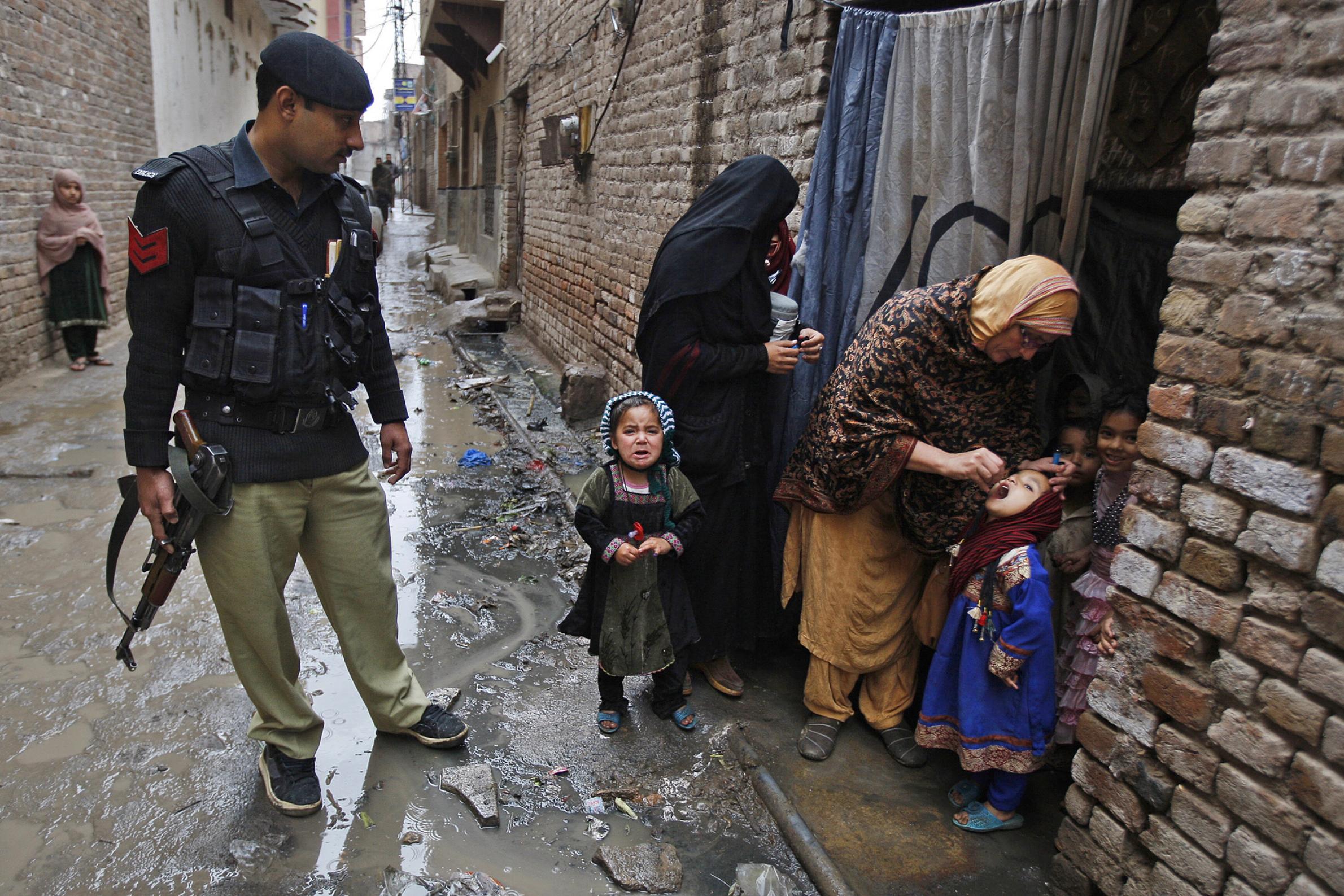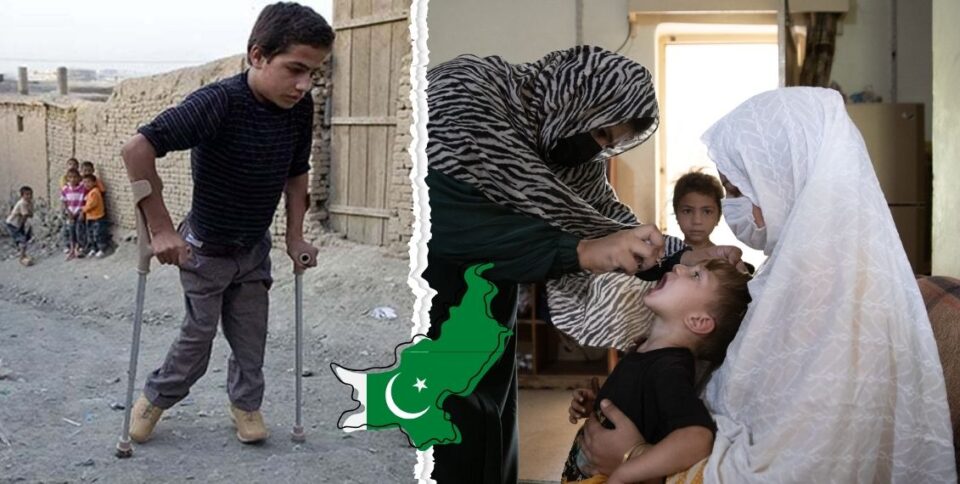Polio, Pakistan: Polio in Pakistan seems untamable. With two new polio virus cases confirmed recently in Sindh’s Badin and Thatta districts, as per Pakistan’s National Institutes of Health (NIH), the nationwide tally reaches 29 for this year and the total number of cases in the province to nine. While most of the South Asian countries including India have eradicated this paralysing virus and the whole of Europe erased it decades ago, Pakistan, and to an extent Afghanistan, struggle to cease the spread of the deadly virus which strike children and leave them paralytic for life with absolutely no cure. 29 cases this year alone in Pakistan leaves a big question mark not only on the immunisation programs and but also puts under the lens the effective implementaion of international protocols in the fight against Polio Virus.
While the world conquered the Polio with just ‘two drops’ of life for immunisation against Polio virus, it is important to explore the gaps in Pakistan’s polio policies, effective implemetaion and possible solutions.
Polio Cases in Pakistan Today
Pakistan remains one of just two countries alongside Afghanistan where wild poliovirus type 1 (WPV1) spreads endemically, defying global eradication efforts. As of late September 2025, the country has confirmed 29 WPV1 cases, a sharp rise from earlier in the year and more than double the 13 cases by June. These cases are unevenly distributed: 18 in the northwest Khyber Pakhtunkhwa (KP) province, 9 in southern Sindh, and one each in Punjab and Gilgit-Baltistan.

Environmental surveillance paints an even grimmer picture, with 71 WPV1-positive sewage samples detected early in 2025, signaling silent circulation in urban hotspots like Karachi and rural pockets along the Pakistan-Afghanistan border. The Global Polio Eradication Initiative (GPEI) reports no new cases in the past week as of October 1, but the total for 2025 stands at 29, compared to 74 in 2024, showing persistent but contained transmission. This virus, which spreads through fecal-oral routes in areas with poor sanitation, mainly affects children under five, causing irreversible paralysis in about one in 200 infections.
Comparison with Other South Asian Countries
South Asia tells a tale of two realities: Pakistan’s struggle versus the region’s resounding success. India, Bangladesh, Nepal, Sri Lanka, Bhutan, and the Maldives have reported zero WPV1 cases in 2025 and for over a decade. The WHO’s South-East Asia Region, which includes these nations, was certified polio-free in 2014 after India’s last wild case in January 2011.
In contrast, Pakistan’s cases highlight geographic expansion into new areas like Gilgit-Baltistan, while its neighbors sustain interruption through routine immunization coverage above 90% and vigilant surveillance. For instance, Bangladesh and Nepal, once high-risk, now focus on preventing vaccine-derived strains via integrated health systems, without the endemic wild virus Pakistan battles. This disparity underscores how South Asia’s stability, minus Pakistan’s conflict zones enabled collective certification, but cross-border risks with Afghanistan keep Pakistan’s virus alive.
Circulating vaccine-derived poliovirus type 2 (cVDPV2) outbreaks occur elsewhere globally, with 67 cases in 2025, but South Asian countries excluding Pakistan remain free of both wild and major vaccine-derived threats. Pakistan’s isolation in the region amplifies the urgency: while neighbors moved on, its 29 cases in 2025 make it the global epicenter of WPV1.
Why Polio Persists in Pakistan: Root Causes and Government Shortfalls
Polio’s grip on Pakistan stems from a toxic mix of insecurity, misinformation, and operational hurdles, allowing the virus to thrive in “reservoirs” like the Quetta Block in Balochistan, southern KP, and Karachi. Violence against vaccinators rooted in past CIA-linked incidents disrupts campaigns, forcing teams to skip homes or operate under armed escorts, leaving children unvaccinated. Porous borders with Afghanistan fuel bi-directional spread, as families move freely, seeding the virus across the “southern corridor”.

Vaccine hesitancy is rampant, fueled by rumors that the oral polio vaccine (OPV) causes infertility or is a Western plot, leading to refusals in up to 20% of households in high-risk areas. Poor routine immunization—below 80% in some districts creates immunity gaps, exacerbated by urban slums and nomadic groups evading outreach. Environmental factors like inadequate sanitation amplify fecal-oral transmission in these pockets.
The government’s efforts show commitment but reveal failures in execution. Pakistan runs frequent national immunization days (NIDs) and sub-national campaigns: a September 2025 drive reached 21 million children in 88 districts, and an October NID from October 13-19 targets 45.4 million with OPV and vitamin A, involving 400,000 workers.
Yet, WHO critiques persistent “missed children” due to uneven microplanning, over-reported coverage, and fatigue after near-misses in 2018-2019. Political instability, budget shortfalls, and provincial coordination lapses mean campaigns hit numbers but not quality evident in rising environmental positives despite rounds. In short, the government mobilizes scale but falters on trust-building and last-mile access, letting the virus rebound.
Why Polio Has Been a Stubborn Disease in South Asia
Polio has proven stubbornly resilient in South Asia due to a deadly mix of dense populations, poor sanitation, high migration, and deep-seated socio-political mistrust that fueled vaccine resistance and uneven access. The region’s history of communal tensions, starting from the 1947 Partition of India which displaced millions and sparked riots, led to segregated slums where Muslims often socio-economically marginalized faced neglect in basic services like water and sewage, creating perfect breeding grounds for the fecal-oral virus. Rumors of vaccines as “Western plots“ to sterilize Muslims, amplified by past forced family planning in the 1970s and rising Hindu nationalism in the 1990s, bred widespread refusal, especially in Muslim-majority areas.
India’s struggle exemplified this tenacity: once the global epicenter with over 200,000 cases yearly in the 1980s, it battled massive disparities where 70% of 2002’s 1,600 cases were among Muslim boys under two in Uttar Pradesh, linked to slum poverty, riot-induced segregation, and covert resistance like hiding children during campaigns.
Despite near-misses – polio rebounded in 2002 after early targets failed due to operational gaps and fatigue, India’s intense, localized efforts eventually broke the cycle. Afghanistan mirrors these woes on steroids: endless conflict, Taliban bans on female vaccinators (who deliver most doses), and politicized health as “bargaining” against drone strikes have kept WPV1 alive since 1988, with 18 cases in 2024 and 44 environmental positives amid COVID disruptions and misinformation.
Southern provinces like Kandahar remain hotspots, with cross-border flows seeding Pakistan, turning the duo into the world’s last endemic holdouts. Other nations like Bangladesh overcame similar hurdles through community trust-building, but South Asia’s polio persistence until 2014 highlights how historical scars, insurgencies, and inequality let the virus outlast global pushes
India’s Successful No-Polio Campaign
India’s journey from polio hyperendemic over 200,000 cases annually in the 1980s to zero since 2011 offers a blueprint Pakistan can adapt. Declared polio-free by WHO in 2014, India tackled similar challenges: dense populations, poverty, migration, and mistrust in states like Uttar Pradesh and Bihar.

Key strategies included:
-
Pulse Polio Mass Campaigns: Launched in 1995, these involved two annual NIDs vaccinating 170 million children via 2.3 million booths and door-to-door teams, plus sub-national rounds in hotspots. Mop-up operations followed any alert, ensuring 95%+ coverage.
-
Robust Surveillance: A network of 30+ labs tested stool from every acute flaccid paralysis (AFP) case requiring two per 100,000 children annually and sewage samples from 50+ cities caught silent spread early.
-
Micro-Planning and Logistics: Teams mapped every household, transit point, and slum, using female vaccinators for trust. The Electronic Vaccine Intelligence Network (eVIN) tracked cold chains in real-time, preventing stockouts.
-
Community Engagement: Bollywood stars, religious leaders, and door-to-door education countered myths, boosting acceptance from 60% to over 99%. Political will was key: Prime Ministers championed it, with district officials held accountable.
-
Integration and Innovation: By 2016, India switched to inactivated polio vaccine (IPV) in routines for endgame protection, while training 1 million+ volunteers sustained momentum.
These steps interrupted transmission despite odds, certifying the region polio-free and preventing 1.5 million cases globally. India’s lesson: relentless, localized action beats any virus.
Lessons from Other Nations & Why Europe Has No Trace of Polio
Other countries echo India’s playbook. Bangladesh used community health workers for 95% coverage in slums, while Nigeria’s post-2020 resurgence was curbed by door-to-door drives and misinformation counters, dropping cases from 33 in 2018 to zero wild by 2020 (though cVDPV persists). Globally, the GPEI’s 2022-2026 strategy emphasizes risk-based interventions, like Pakistan’s corridor focus.
Europe stands as a gold standard, with no indigenous wild polio since 2002 and the region certified polio-free in 2002. High routine IPV coverage over 95% since the 1960s, interrupted transmission early, as Jonas Salk’s and Albert Sabin’s vaccines rolled out post-WWII epidemics. Advanced sanitation and water systems slashed fecal-oral risks, while the European Centre for Disease Prevention and Control (ECDC) dashboard tracks importations via AFP surveillance and sewage monitoring.
 Swift responses to rare detections like 2022 Ukraine cases from conflict prevent re-establishment, backed by public trust in vaccines (90%+ uptake) and EU-wide coordination. Europe’s edge: early infrastructure, consistent routines, and no endemic reservoirs make it a “fragile legacy” maintained by vigilance, not just campaigns.
Swift responses to rare detections like 2022 Ukraine cases from conflict prevent re-establishment, backed by public trust in vaccines (90%+ uptake) and EU-wide coordination. Europe’s edge: early infrastructure, consistent routines, and no endemic reservoirs make it a “fragile legacy” maintained by vigilance, not just campaigns.
A Path Forward for Pakistan
Pakistan can end polio by borrowing from these models. First, enhance access: Deploy more female-led teams with security in KP and border areas, synchronizing NIDs with Afghanistan for the Quetta-South corridor. Second, build trust: Partner with imams, celebrities, and mothers’ groups to debunk myths, aiming for 100% acceptance via targeted social media and village meetings.
Third, strengthen routines: Integrate IPV into schedules, using digital tools like India’s eVIN for cold-chain tracking and zero-dose hunts. Fourth, boost surveillance: Expand sewage testing to 100+ sites and AFP reporting, with rapid mop-ups. Finally, secure funding and leadership: Provincial governors must own districts, with GPEI partners auditing campaigns for quality.
A phased plan: October’s NID as a trust-builder, followed by monthly sub-nationals in hotspots, monitoring via dashboards until 12 months virus-free. Risks remain 29 cases signal expansion but with India’s intensity and Europe’s sustainment, Pakistan could join the polio-free club by 2027.
In 2025, polio’s shadow looms over Pakistan’s children, but the virus is beatable. Neighbors proved it; Europe locked it away. Now, it’s time for full commitment, no more missed shots, no more excuses. The drops that saved India await in every Pakistani home.
https://x.com/narendramodi/status/1976251378008748084

